Mybatis的多对一和一对多处理
Written on: 5月 02, 2021
Title : Mybatis的多对一和一对多处理
link : Mybatis的多对一和一对多处理
Mybatis的多对一和一对多处理
Mybatis的多对一和一对多
1.Lombok
首先我们来看下Lombok,百度搜以下Lombok,找到官网:https://projectlombok.org/
官网有这么一句话:
Project Lombok is a java library that automatically plugs into your editor and build tools, spicing up your java.Never write another getter or equals method again, with one annotation your class has a fully featured builder, Automate your logging variables, and much more.使用步骤:
1.在IDEA中安装Lombok插件!
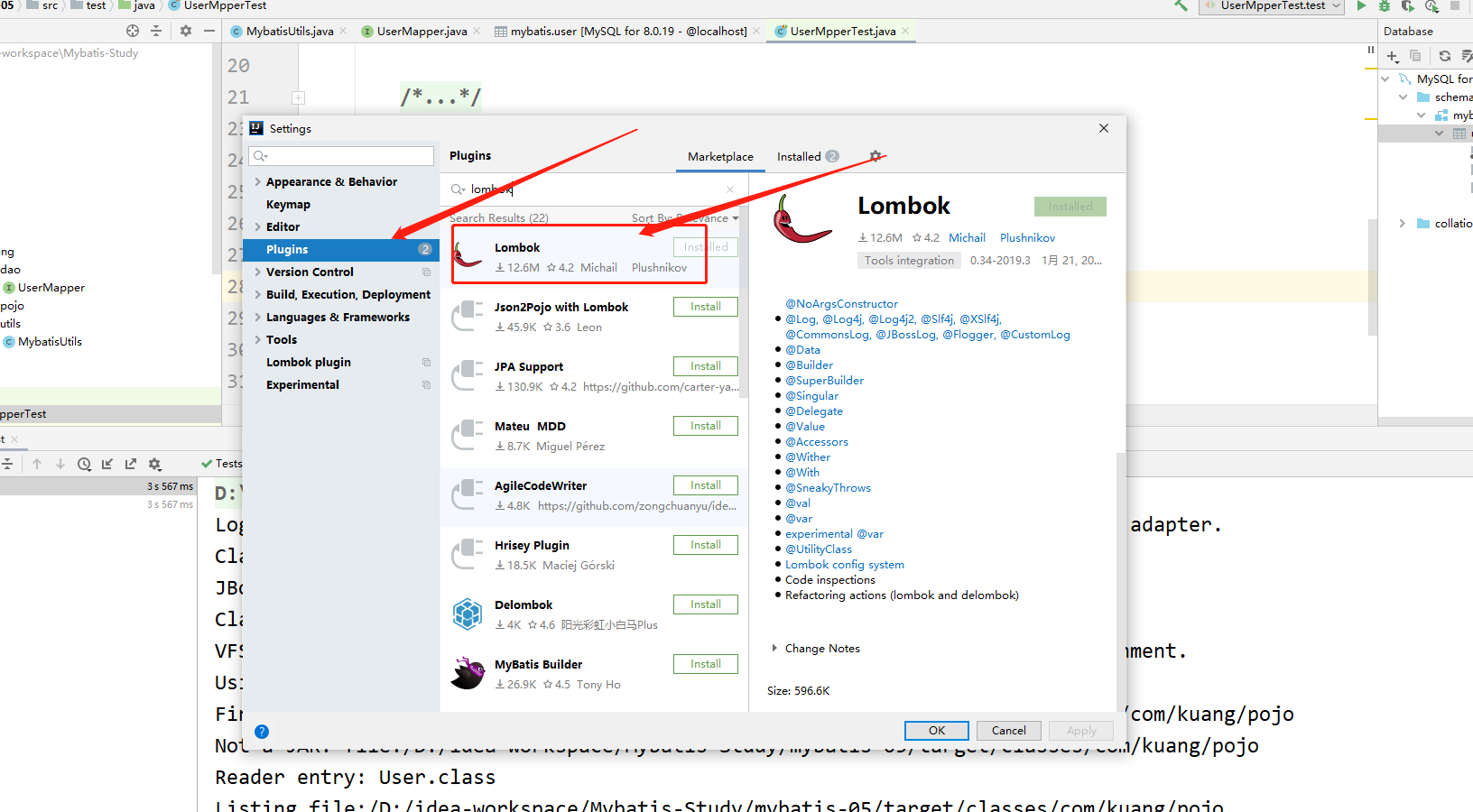
2.在项目中导入lombok的jar包
直接去maven仓库官网搜 Lombok maven
<!-- https://mvnrepository.com/artifact/org.projectlombok/lombok --><dependency> <groupId>org.projectlombok</groupId> <artifactId>lombok</artifactId> <version>1.18.20</version> <scope>provided</scope></dependency>3.在实体类上加注解即可
Lombok有以下的注解可供使用:
@Getter and @Setter@FieldNameConstants@ToString@EqualsAndHashCode@AllArgsConstructor, @RequiredArgsConstructor and @NoArgsConstructor@Log, @Log4j, @Log4j2, @Slf4j, @XSlf4j, @CommonsLog, @JBossLog, @Flogger, @CustomLog@Data@Builder@SuperBuilder@Singular@Delegate@Value@Accessors@Wither@With@SneakyThrows@val@var说明:
@Data: 无参构造、getter、setter、toString、hashcode、equals@AllArgsConstructor:有参构造@NoArgsConstructor:无参构造@ToString:生成toString方法@EqualsAndHashCode:生成equeals和hashcode方法2.多对一处理
多对一

- 多个学生,对应一个老师
- 对于学生这边而言,和老师存在关联关系,多个学生关联一个老师【多对一】
- 对于老师而言,和学生存在集合关系,一个老师有很对学生【一对多】
搭建复杂环境用的SQL:
CREATE TABLE `teacher` ( `id` INT(10) NOT NULL, `name` VARCHAR(30) DEFAULT NULL, PRIMARY KEY (`id`)) ENGINE=INNODB DEFAULT CHARSET=utf8INSERT INTO teacher(`id`, `name`) VALUES (1,'秦老师'); CREATE TABLE `student` ( `id` INT(10) NOT NULL, `name` VARCHAR(30) DEFAULT NULL, `tid` INT(10) DEFAULT NULL, PRIMARY KEY (`id`), KEY `fktid` (`tid`), CONSTRAINT `fktid` FOREIGN KEY (`tid`) REFERENCES `teacher` (`id`)) ENGINE=INNODB DEFAULT CHARSET=utf8INSERT INTO `student` (`id`, `name`, `tid`) VALUES (1, '小明', 1); INSERT INTO `student` (`id`, `name`, `tid`) VALUES (2, '小红', 1); INSERT INTO `student` (`id`, `name`, `tid`) VALUES (3, '小张', 1); INSERT INTO `student` (`id`, `name`, `tid`) VALUES (4, '小李', 1); INSERT INTO `student` (`id`, `name`, `tid`) VALUES (5, '小王', 1);测试环境搭建
1.导入Lombok
2.新建实体类Teacher、Student
3.建立Mapper接口
4.建立Mapper.
5.在核心配置文件中绑定注册我们的mapper接口或者文件
6.测试查询是否能够成功
以上不走不用多说,前面搭建过很多次
这里主要注意一点:mapper接口文件放在src/main/java的某个目录(com/kuang/dao)下面和mapper.
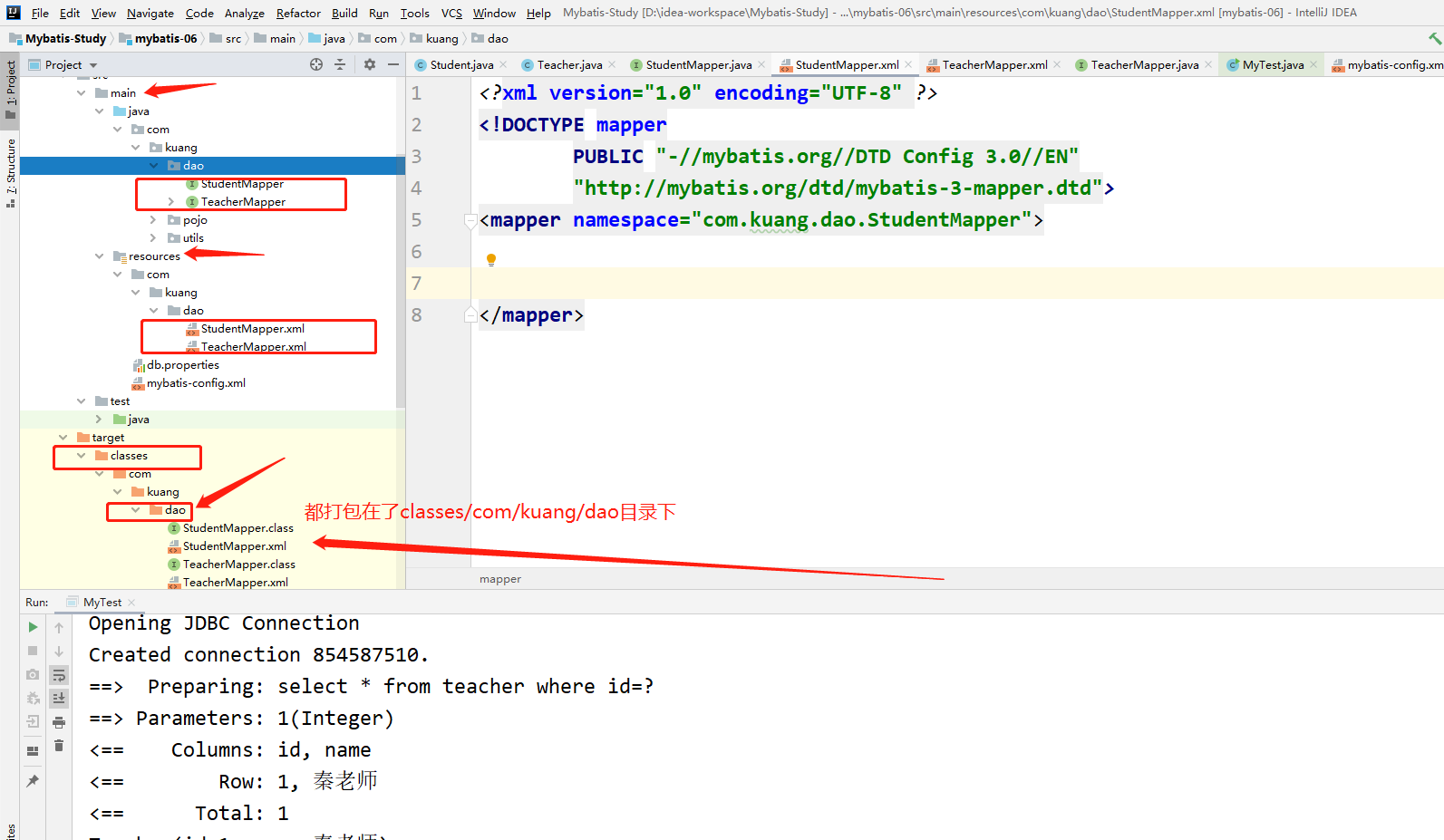
现在我们来写一下多对一
按照查询嵌套处理
<!-- 思路: 1.查询所有的学生信息 2.根据查询出来的学生的tid,寻找对应的老师! --><resultMap id="StudentTeacher" type="Student"> <result property="id" column="id"/> <result property="name" column="name"/> <!--复杂的属性,我们需要单独处理 对象:association 集合:collection --> <association property="teacher" column="tid" javaType="Teacher" select="getTeacher"/></resultMap><select id="getStudent" resultMap="StudentTeacher"> select * from student;</select><select id="getTeacher" resultType="Teacher"> select * from teacher where id = #{id}</select>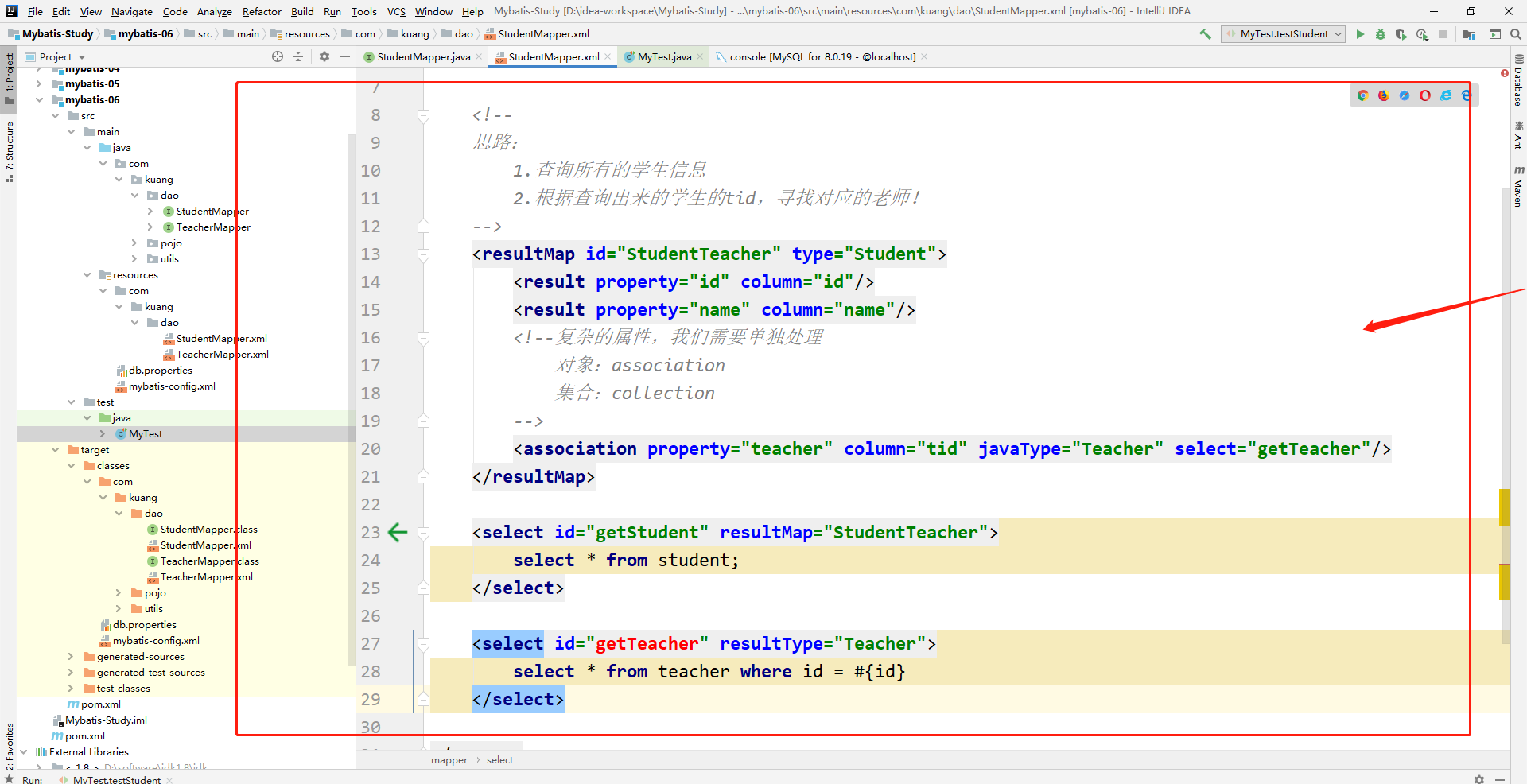
按照结果嵌套查询
<!--按照结果嵌套处理--><select id="getStudent2" resultMap="StudentTeacher2"> select s.id sid,s.name sname,t.`name` tname from student s,teacher t where s.tid = t.id</select><resultMap id="StudentTeacher2" type="Student"> <result property="id" column="sid"/> <result property="name" column="sname"/> <association property="teacher" javaType="Teacher"> <result property="name" column="tname"/> </association></resultMap>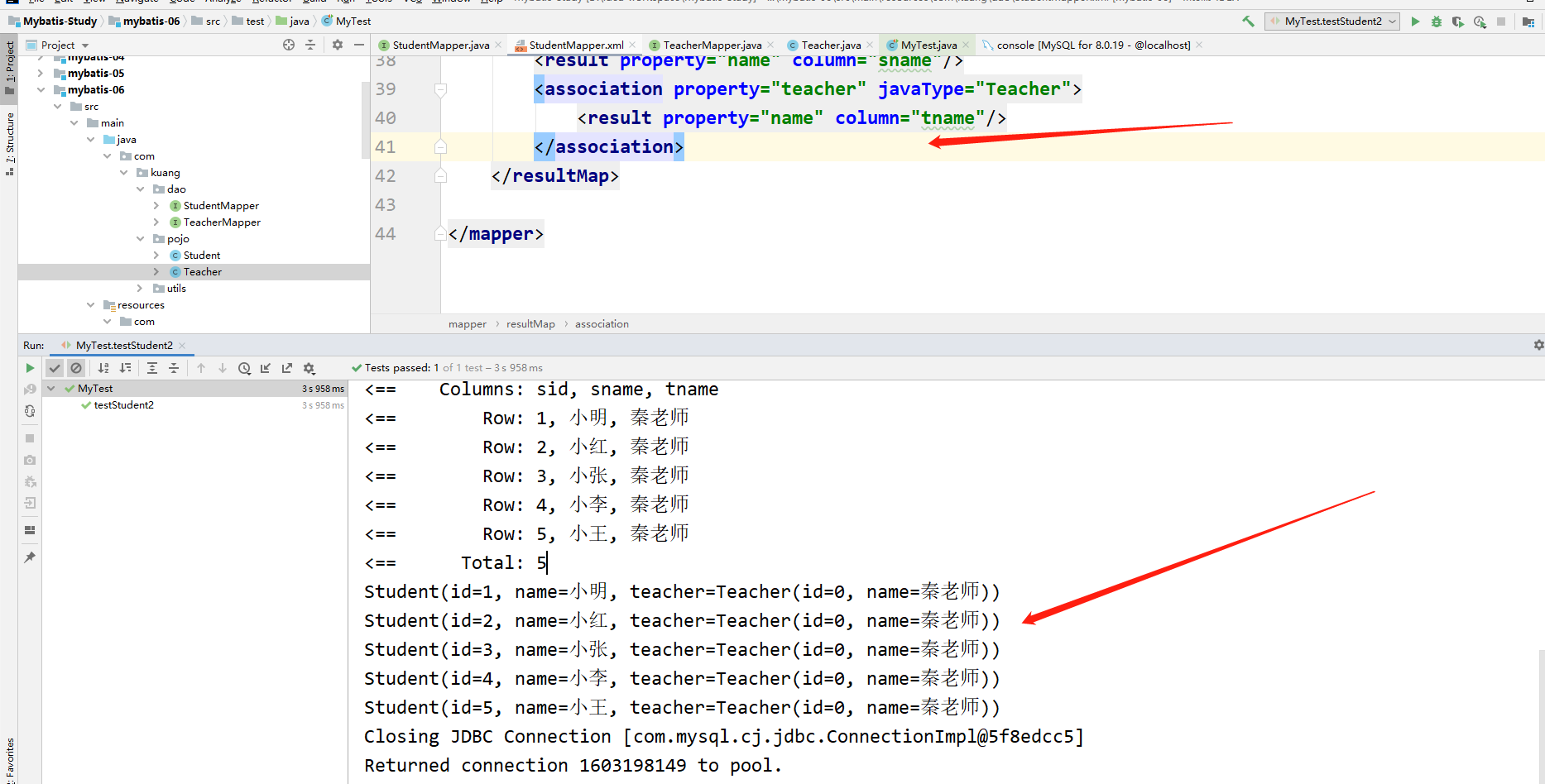
回顾Mysql多对一查询方式:
- 子查询: 相当于按照查询嵌套处理
- 联表查询:相当于按照结果嵌套处理
3.一对多处理
比如:一个老师拥有多个学生!
对于老师而言,就是一对多的关系!
1.环境搭建
环境搭建和刚才一样
实体类
@Datapublic class Student { private int id; private String name; private int tid;}@Datapublic class Teacher { private int id; private String name; //一个老师拥有多个学生 private List<Student> students;}按照结果嵌套处理
就是相当于复杂sql写完了,本身数据查询出来就是一个集合的形式,最终我们要封装成一个实体类Teacher的形式,但是属性名和sql查出来的字段名不一致,用collection标签做如下处理即可:
<!--按结果嵌套查询--><select id="getTeacher" resultMap="TeacherStudent"> select s.id sid,s.name sname,t.name tname,t.id tid from student s,teacher t where s.tid = t.id and t.id=#{tid}</select><resultMap id="TeacherStudent" type="Teacher"> <result property="id" column="tid"/> <result property="name" column="tname"/> <!-- 复杂类型我们需要单独处理: 对象:association 集合:collection javaType="" 指定属性的类型 集合中的泛型信息,我们使用ofType获取 --> <collection property="students" ofType="Student"> <result property="id" column="sid"/> <result property="name" column="sname"/> <result property="tid" column="tid"/> </collection></resultMap>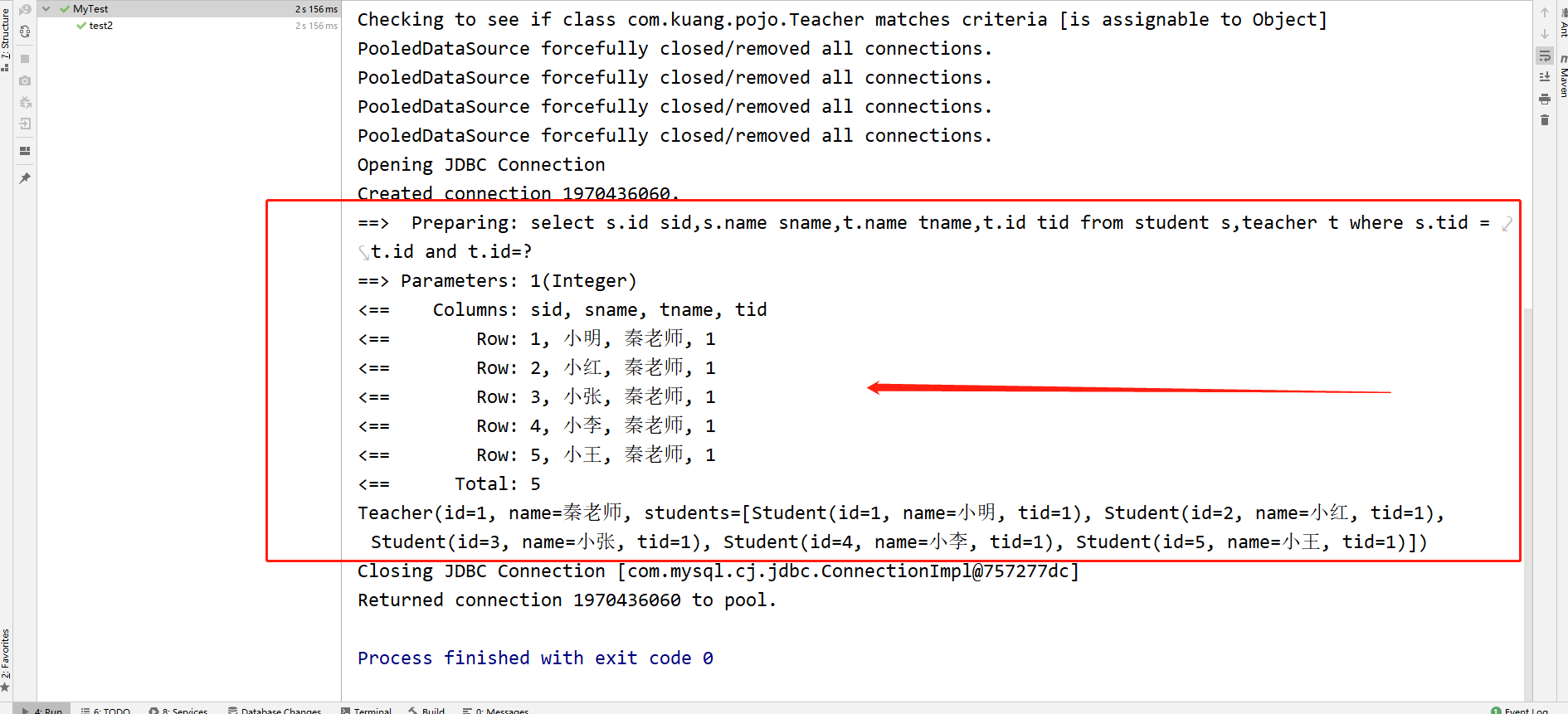
按照查询嵌套处理
按照查询嵌套处理的话:这是另一种思路,就是先查老师,由于第一个sql只查出了老师的id和name,需要用collection标签用如下方法将老师的id传给下面另一个sql语句,就能够查询改老师下所有的学生并封装到实体类list集合当中。
这里须注意如果resultMap中不加
<!--按照查询嵌套处理--><select id="getTeacher2" resultMap="TeacherStudent2"> select * from teacher where id=#{tid}</select><resultMap id="TeacherStudent2" type="Teacher"> <result property="id" column="id"/> <collection property="students" javaType="ArrayList" ofType="Student" select="getStudentByTeacherId" column="id"/></resultMap><select id="getStudentByTeacherId" resultType="Student"> select * from student where tid=#{id}</select>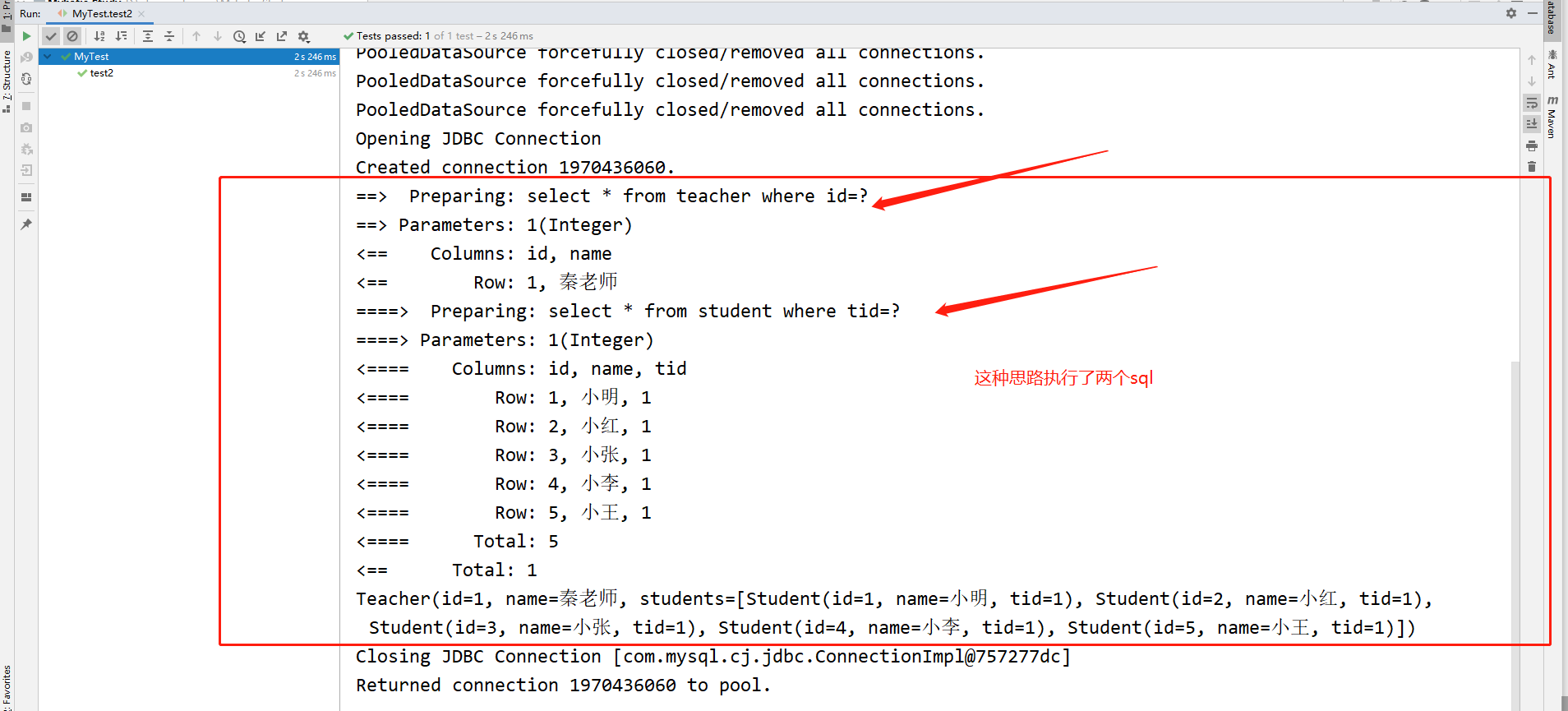
4.小结
1.关联 - association 【多对一】
2.集合 - collection 【一对多】
3.javaType :用来指定实体类中属性的类型,ofType:用来指定映射到list或者集合中的pojo类型,泛型中的约束类型!
综合:无论是多对一还是一对多,都建议使用按结果嵌套处理的方式来做,因为出了问题,按查询嵌套处理并不好调试!(想想,按结果嵌套处理的方式还可以调试下sql,但按查询嵌套处理怎么调呢?)
注意点:
- 保证SQL的可读性,尽量保证通俗易懂
- 注意一对多和多对一中,属性名和字段的问题!
- 如果问题不好排查错误,可以使用日志!
这篇文章的源码在Mybatis-study工程的mybatis-06和mybatis-07模块下!,后面会给出码云地址。
原文转载:http://www.shaoqun.com/a/720750.html
抢注商标:https://www.ikjzd.com/w/1053
6pm:https://www.ikjzd.com/w/317
Mybatis的多对一和一对多1.Lombok首先我们来看下Lombok,百度搜以下Lombok,找到官网:https://projectlombok.org/官网有这么一句话:ProjectLombokisajavalibrarythatautomaticallyplugsintoyoureditorandbuildtools,spicingupyourjava.Neverwriteanothe
hemingway:https://www.ikjzd.com/w/2344
trademanager:https://www.ikjzd.com/w/730
hunter:https://www.ikjzd.com/w/992
logo免费制作:https://www.ikjzd.com/w/1998
Google核心算法重大更新!你的网站受到影响了吗?:https://www.ikjzd.com/home/136866
为生女孩 老婆规定只能傍晚行房:http://lady.shaoqun.com/m/a/272595.html
That's the article Mybatis的多对一和一对多处理
You are now reading the article Mybatis的多对一和一对多处理 with link address https://kanakoroku.blogspot.com/2021/05/mybatis.html
